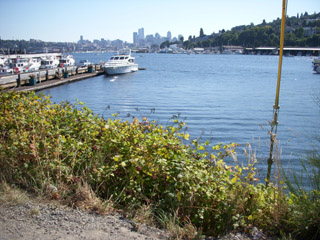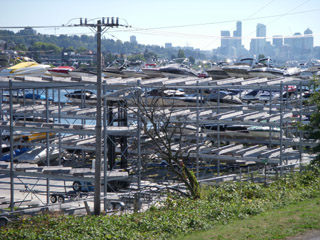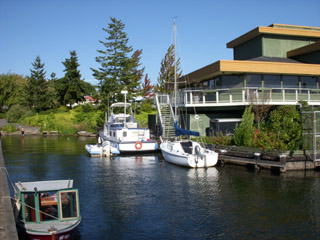
DJC.COM
September 25, 2008
Seattle’s waterfront a showcase of lost opportunities

Surdyke
|
Puget Sound is experiencing a renaissance in waterfront development.
With Tacoma and Bremerton taking the lead, cities like Bellingham, Everett and Vancouver, Wash., are now implementing comprehensive waterfront plans to encourage mixed-use development and public open space, while at the same time preserving maritime uses.
By contrast, Seattle has traditionally turned its back on this subject for the sake of preserving “family-wage jobs.” Land-use policies and local politicos have favored status quo industrial and commercial uses, and now Seattle finds itself as one of the few cities on either coast without a comprehensive strategy for its urban waterways.
Cities like Tacoma, Baltimore, Vancouver, British Columbia, and now Bremerton, have proven they can develop mixed-use waterfronts with plentiful open space while maintaining a thriving maritime industry. With the addition of up to 100,000 new residents over the next 20 years, Seattle needs to acknowledge the changing needs for its urban waterways, including improved public access and shoreline restoration to sustain our quality of life.

The city could build a park and restore habitat along this neglected stretch of Lake Union shoreline at the end of Stone Way. |
In spite of the recent addition of waterfront open space downtown (Olympic Sculpture Park and Lake Union Park), many of Seattle’s close-in waterfront neighborhoods (Eastlake, Wallingford, Fremont, Ballard, Interbay) are seeing underutilized or vacant waterfront sites develop as private office buildings, with little or no public access.
Zoning that was meant to encourage maritime industry has also provided loopholes for commercial buildings, housing everything from architects and attorneys to software companies. Additionally, without design review or a thorough public review process, the resulting new structures generally lack the public amenities that have become a priority in other waterfront cities.
Without a strategic plan, Seattle continues to miss opportunities essential for providing additional open space, public enjoyment and habitat restoration along its waterways.
Blown chances

Vertical boat-storage obstructs views of Lake Union. Wallingford residents objected to earlier plans for a mixed-use development that would have brought cafes and open space to the site. |
Seattle has seen numerous recent examples of missed opportunities for providing new waterfront open space. With locked gates, increased impervious surfaces and surface parking, attributes of some of these projects would be unheard of in cities like Tacoma or Vancouver, British Columbia.
• The Amgen Campus. When Immunex purchased its 13-acre site from the Port of Seattle in the early 1990s, it developed a campus that included acres of lushly landscaped open space abutting the north end of Myrtle Edwards Park.
Unfortunately, it also built a 4-foot-high fence around the entire campus, ensuring that the enjoyment of this vast open space would be exclusive its employees.
Amgen (which acquired Immunex in 2002) has since increased the size of its land holdings, acquiring several adjacent low-rise office and storage buildings. Those buildings have since been razed and paved over with asphalt, with future building phases put on hold.
Without a city plan in place that requires a true public review process, Amgen has increased the size of its perimeter fence and no further public amenities or improvements have been announced. With future phases on hold, now would be a perfect time for the city to initiate discussions with Amgen and the community to explore short- and long-term public amenities on this site.
• Northlake mixed-use project. Several years ago when a developer proposed a hotel-residential project on the north side of Lake Union, Wallingford residents came out en masse to oppose any zoning change that would block their views.
Even though the project would have preserved view corridors and provided public open space, there was no plan or city support for the development proposal. Though the neighborhood felt it won a victory when the project finally died, the resulting land use is truly a lost opportunity for that community.
A new dry-stack marina on the site is now one of the densest multistory boat-storage facilities in Seattle. With stacks of boats up to 45 feet high, the facility blocks most or all of the water views that were previously of neighborhood concern, and its paved and green surfaces are completely private.
This unfortunate use in such a central location could be a poster child for other cities of what not to do on an urban waterfront.
Parking. Without a plan or component that mitigates parking impacts, Seattle’s “new waterfront” is in danger of continuing its proliferation of impermeable surfaces.
Parking has become the predominant use for open space adjacent to new commercial structures. Examples include the Amgen Campus, the newly renovated Northlake Building and the new office buildings at the Salmon Bay Marine Center in Interbay.
New opportunities

Redevelopment of Ballard’s Yankee Diner site could provide open space and waterfront access for the neighborhood’s growing urban center. |
Yankee Diner site. This Ballard site, featuring a vacant restaurant on 1.2 acres with surface parking for 120 vehicles, has been earmarked for a 175-room hotel.
Recent industrial zoning changes may have closed the loophole for mixed use, but this large area, which abuts a public pier and the Salmon Bay waterfront, could provide welcome public access for Ballard’s thriving downtown.
With over 2,000 residential units planned or under way, Ballard’s increasingly dense urban center would benefit greatly from additional open space. Public access to the waterfront has never been an aspect of downtown Ballard, so a new development on this site could provide a unique opportunity to enhance the quality of life for this waterfront community (which currently has little or no immediate waterfront access).
Waterway 22. Between the barbed wire at the west end and the cascading blackberry bushes, one wouldn’t think that there’s much to this 150-foot stretch of Fremont-Wallingford waterfront.
But this site, where Stone Way meets Lake Union, offers spectacular views of the lake and downtown Seattle, and could provide an opportunity for natural shoreline enhancement and waterfront access. Though there is no adjacent development opportunity to pursue a public-private solution, perhaps funds from the Seattle Parks bonds or neighborhood matching grants could be obtained to transform this overgrown blackberry patch into a natural, accessible amenity for the community.
Tacoma’s success
Tacoma took a bold step forward in creating the Foss Waterway Development Authority.
Modeled after the Portland Development Commission,the development authority was charged with developing and implementing a master plan for a 1.5-mile stretch of the downtown waterfront. Utilizing the street ends as opportunities to reconnect the Foss Waterway with the downtown core, the development authority designed a master plan requiring that developers provide street-level parks and piazzas abutting their projects, all connected by a grand public esplanade.
The plan has resulted in several hundred million dollars in development, including the Museum of Glass and several large apartment and condominium projects. The result is a pedestrian-oriented waterfront that is unique to our region.
The next project planned is the Foss Waterway Seaport, a regional maritime education and activity center. Also under way is the planning for Foss Harbor, a waterfront development that may include mixed-use towers of up to 180 feet on the waterfront, in exchange for additional public open space and view corridors.
A fresh look
Seattle’s waterfront land-use policies seem to have fostered a mindset of “Keep out! Private property,” rather than a mindset that this essential amenity should be accessible to everyone where possible.
Urban waterfronts worldwide are seen as a critical public asset for quality of life and an opportunity for habitat restoration. Rather than ignore this changing tide, the city of Seattle needs to step up and evaluate the relevance of its current land-use limitations and encourage multiple uses for urban waterways that are appropriate for the 21stt century.
The city’s new planning director, Ray Gastil, brings a wealth of knowledge on urban waterfronts. His expertise may be just what Seattle needs in order to take a fresh look at the changing social and economic needs for its urban waterways. Gastil will be involved in the city’s efforts to update all of its neighborhood plans, which include urban waterways.
Rather than relegating waterfront planning to individual neighborhoods or taking a broad-brush zoning approach, perhaps the diversity of Seattle’s urban waterways can be acknowledged and therefore be subject to appropriately diverse uses going forward. This may lend itself to more land-use flexibility and site-specific solutions.
An advisory committee could be established that weighs the opportunities and demands for these limited sites. Similarly, a waterway authority could provide mediation between competing interests (such as. industrial uses, private office space, habitat restoration and bike trails/public access) and could advise the city on implementing flexible and appropriate land-use policies.
Balanced waterfront plan
Seattle has been focused on the long-term vision of what will happen on its “post-viaduct” central waterfront. In the meantime, the city is missing opportunities to provide diverse uses and public amenities on its close-in urban waterways.
Too many office buildings and private parking lots are swallowing up these precious sites. True maritime industry can continue to flourish, but at the same time an appropriate balance of mixed uses and public amenities will improve quality of life and the shoreline environment.
Whether non-water-dependent industrial uses or residential and commercial uses are allowed, the goal should be to ensure a relevant, balanced waterfront plan that considers and explores opportunities for public benefits before those opportunities are lost.
Scott Surdyke is a development manager specializing in urban mixed-use and residential projects. He has consulted on projects for Tacoma’s Foss Waterway and has managed the development of mid- and high-rise projects in Seattle.
Other Stories:
- Put mixed uses where they belong — by the water
- 5 principles for renewing Seattle’s waterfront
- Group efforts make for better shorelines
- Competing goals drive Anacortes marina project
- Redevelopment: fraught with challenges, but worth the plunge
- Great civic developments need private know-how
Copyright ©2009 Seattle Daily Journal and DJC.COM.
Comments? Questions? Contact us.